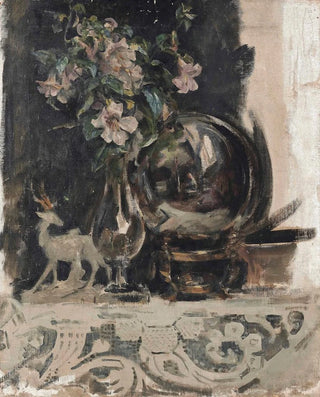Art print | Still life of flowers, a statue, and a globe on a fireplace - James Jebusa Shannon


View from behind

Frame (optional)
James Jebusa Shannon's artwork, titled "Reproduction of a Still Life of Flowers, a Statue, and a Globe on a Mantelpiece," invites deep and aesthetic contemplation. In this composition, the artist captures the very essence of fleeting natural beauty while incorporating symbolic elements that evoke permanence and reflection. The flowers, with their brilliance and fragility, blend with the statue, a symbol of immortality, while the globe suggests a vision of the world—an invitation to explore infinity. This piece is a true homage to the harmony between natural and artificial elements, a painting that is not merely a simple representation but a window into the human soul.
Style and uniqueness of the work
Shannon's style is distinguished by striking realism and meticulous attention to detail. Each petal, shadow, and reflection on the globe is rendered with precision that demonstrates remarkable technical mastery. Light plays a crucial role in this composition, creating a play of shadows and highlights that brings the depicted elements to life. The colors, vibrant and nuanced, evoke a sense of freshness and vitality, while also recalling the fleeting nature of beauty. This painting does not merely depict inanimate objects; it tells a story, that of a suspended moment in time where nature and art meet to celebrate the beauty of existence.
The artist and his influence
James Jebusa Shannon, an American-born painter who built his career in Europe, established himself as an emblematic figure of the artistic movement of the late 19th century. Influenced by the Pre-Raphaelite movement and realism, he explored various themes, but it is in the still life that he truly found his voice. His innovative approach, blending tradition and modernity, paved the way for many artists who followed. By incorporating symbolic elements into his works, Shannon succeeded in transcending mere representation to offer a reflection on the human condition. His impact on art is undeniable, and his works continue to inspire and

Matte finish

View from behind

Frame (optional)
James Jebusa Shannon's artwork, titled "Reproduction of a Still Life of Flowers, a Statue, and a Globe on a Mantelpiece," invites deep and aesthetic contemplation. In this composition, the artist captures the very essence of fleeting natural beauty while incorporating symbolic elements that evoke permanence and reflection. The flowers, with their brilliance and fragility, blend with the statue, a symbol of immortality, while the globe suggests a vision of the world—an invitation to explore infinity. This piece is a true homage to the harmony between natural and artificial elements, a painting that is not merely a simple representation but a window into the human soul.
Style and uniqueness of the work
Shannon's style is distinguished by striking realism and meticulous attention to detail. Each petal, shadow, and reflection on the globe is rendered with precision that demonstrates remarkable technical mastery. Light plays a crucial role in this composition, creating a play of shadows and highlights that brings the depicted elements to life. The colors, vibrant and nuanced, evoke a sense of freshness and vitality, while also recalling the fleeting nature of beauty. This painting does not merely depict inanimate objects; it tells a story, that of a suspended moment in time where nature and art meet to celebrate the beauty of existence.
The artist and his influence
James Jebusa Shannon, an American-born painter who built his career in Europe, established himself as an emblematic figure of the artistic movement of the late 19th century. Influenced by the Pre-Raphaelite movement and realism, he explored various themes, but it is in the still life that he truly found his voice. His innovative approach, blending tradition and modernity, paved the way for many artists who followed. By incorporating symbolic elements into his works, Shannon succeeded in transcending mere representation to offer a reflection on the human condition. His impact on art is undeniable, and his works continue to inspire and






